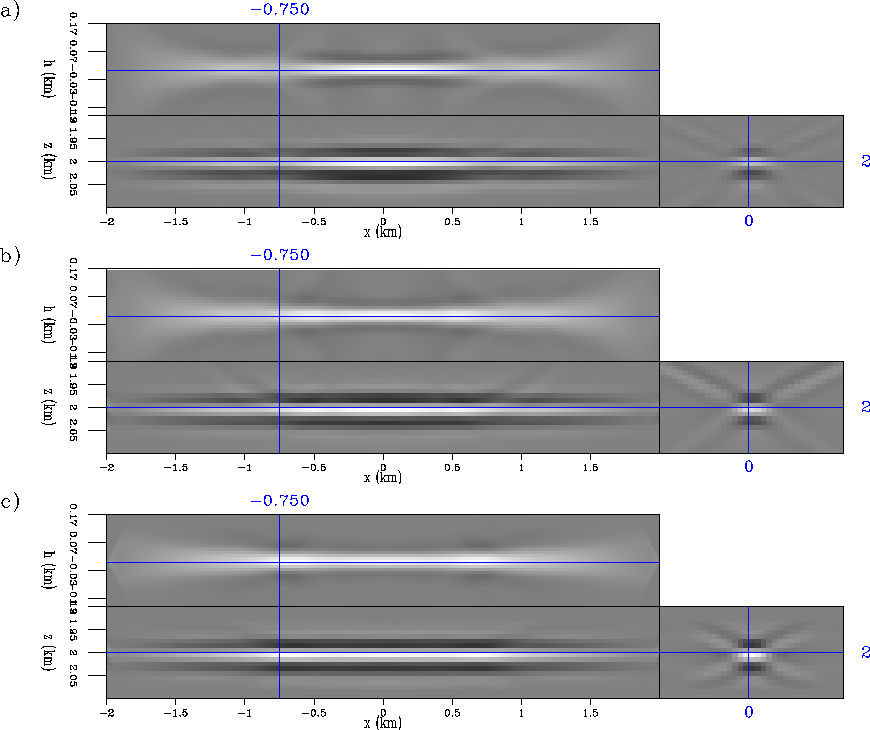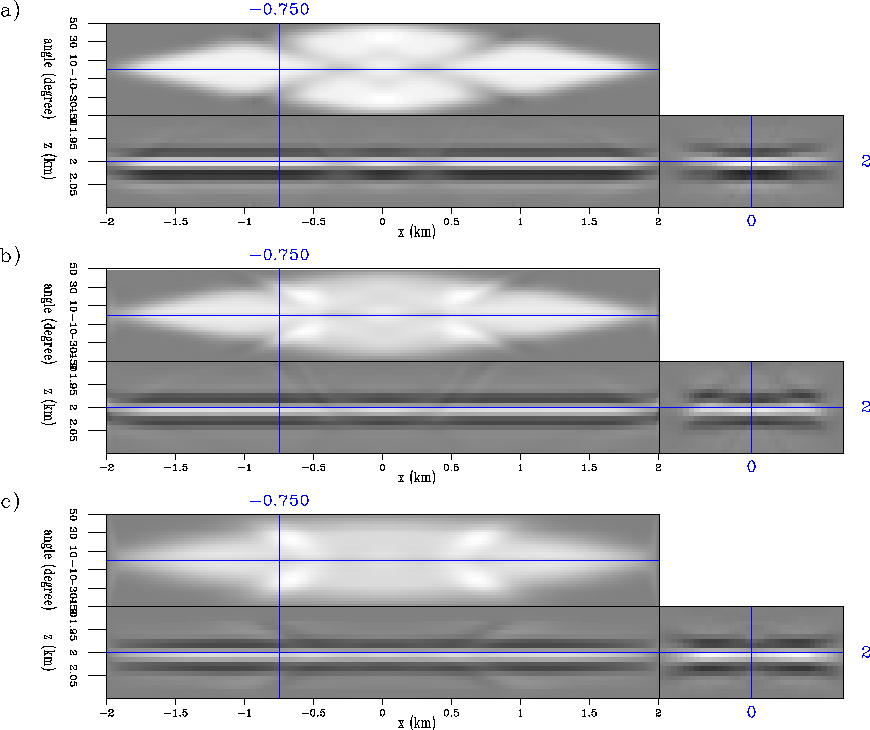




Next: Migration vs. "Hessian impulse
Up: Numerical results
Previous: Modeling
The next step is to compare the subsurface-offset migration results from the two different data sets. Figure ![[*]](http://sepwww.stanford.edu/latex2html/cross_ref_motif.gif) shows a comparison the two-way (
shows a comparison the two-way (![[*]](http://sepwww.stanford.edu/latex2html/cross_ref_motif.gif) a) vs. the one-way modeled data (
a) vs. the one-way modeled data (![[*]](http://sepwww.stanford.edu/latex2html/cross_ref_motif.gif) b) migrations in the subsurface-offset domain. The results are comparable in terms of resolution, but the amplitudes show a different behavior. This is something to expect from the data differences in AVO behavior (Figure
b) migrations in the subsurface-offset domain. The results are comparable in terms of resolution, but the amplitudes show a different behavior. This is something to expect from the data differences in AVO behavior (Figure ![[*]](http://sepwww.stanford.edu/latex2html/cross_ref_motif.gif) ). Even though the images shown in Figure
). Even though the images shown in Figure ![[*]](http://sepwww.stanford.edu/latex2html/cross_ref_motif.gif) are in the sub-surface offset domain, we can see how different they are going to be when transformed to reflection angle by using Sava and Fomel (2003) transformation.
are in the sub-surface offset domain, we can see how different they are going to be when transformed to reflection angle by using Sava and Fomel (2003) transformation.
compare_mig1
Figure 3 Comparison of the migration results in subsurface-offset domain of the two-way (a) vs. the one-way modeled data (b), and vs. the migration "Hessian impulse response" (c) (from equation 3)
![[*]](http://sepwww.stanford.edu/latex2html/movie.gif)





Figure ![[*]](http://sepwww.stanford.edu/latex2html/cross_ref_motif.gif) shows a comparison the two-way (Figure
shows a comparison the two-way (Figure ![[*]](http://sepwww.stanford.edu/latex2html/cross_ref_motif.gif) a) vs. the one-way modeled data (Figure
a) vs. the one-way modeled data (Figure ![[*]](http://sepwww.stanford.edu/latex2html/cross_ref_motif.gif) b) migrations in the reflection angle domain. This result is obtained after applying an offset to angle transformation to the images in Figure
b) migrations in the reflection angle domain. This result is obtained after applying an offset to angle transformation to the images in Figure ![[*]](http://sepwww.stanford.edu/latex2html/cross_ref_motif.gif) . Notice the difference between the illumination patterns in the images. As we discussed in the modeling subsection the images in Figure
. Notice the difference between the illumination patterns in the images. As we discussed in the modeling subsection the images in Figure ![[*]](http://sepwww.stanford.edu/latex2html/cross_ref_motif.gif) a and Figure
a and Figure ![[*]](http://sepwww.stanford.edu/latex2html/cross_ref_motif.gif) b should have different AVA responses. But, from inspecting the figures we can see that they are not that far apart. For most of the a x positions the angle range illumination is the same, being different in intensity. I will discuss the impact of this on the recovery of the AVA in the Inversion subsection.
b should have different AVA responses. But, from inspecting the figures we can see that they are not that far apart. For most of the a x positions the angle range illumination is the same, being different in intensity. I will discuss the impact of this on the recovery of the AVA in the Inversion subsection.
compare_mig2
Figure 4 Comparison of the migration results in reflection angle of the two-way (a) vs. the one-way modeled data (b), and vs. the migration "Hessian impulse response" (c) (from equation 3)
![[*]](http://sepwww.stanford.edu/latex2html/movie.gif)










Next: Migration vs. "Hessian impulse
Up: Numerical results
Previous: Modeling
Stanford Exploration Project
5/6/2007
![[*]](http://sepwww.stanford.edu/latex2html/cross_ref_motif.gif) shows a comparison the two-way (
shows a comparison the two-way (![[*]](http://sepwww.stanford.edu/latex2html/cross_ref_motif.gif) a) vs. the one-way modeled data (
a) vs. the one-way modeled data (![[*]](http://sepwww.stanford.edu/latex2html/cross_ref_motif.gif) b) migrations in the subsurface-offset domain. The results are comparable in terms of resolution, but the amplitudes show a different behavior. This is something to expect from the data differences in AVO behavior (Figure
b) migrations in the subsurface-offset domain. The results are comparable in terms of resolution, but the amplitudes show a different behavior. This is something to expect from the data differences in AVO behavior (Figure ![[*]](http://sepwww.stanford.edu/latex2html/cross_ref_motif.gif) ). Even though the images shown in Figure
). Even though the images shown in Figure ![[*]](http://sepwww.stanford.edu/latex2html/cross_ref_motif.gif) are in the sub-surface offset domain, we can see how different they are going to be when transformed to reflection angle by using Sava and Fomel (2003) transformation.
are in the sub-surface offset domain, we can see how different they are going to be when transformed to reflection angle by using Sava and Fomel (2003) transformation.

![[*]](http://sepwww.stanford.edu/latex2html/movie.gif)
